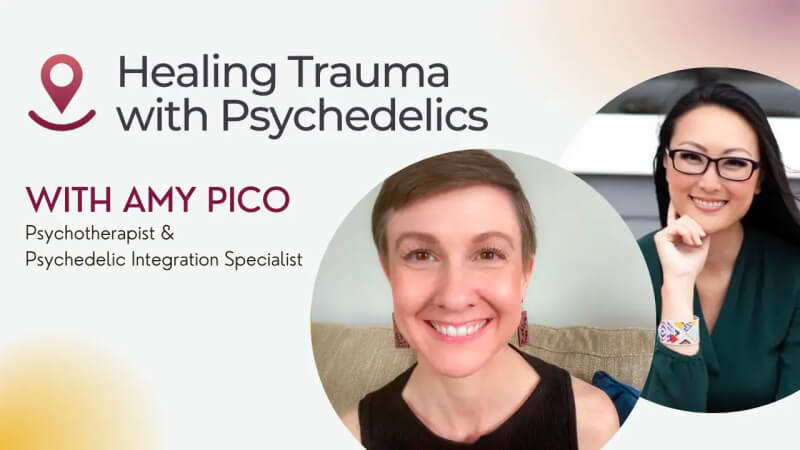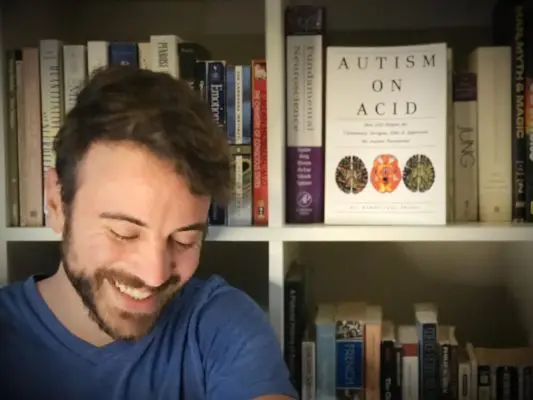I had the pleasure of speaking with Amy Pico, a trauma-informed psychotherapist specializing in psychedelic integration. Amy shares her background, qualifications, and therapeutic approach, highlighting the importance of collaboration and customization in providing support to clients seeking healing through psychedelic therapy. She also delves into the concept of harm reduction and discusses how she creates a safe and supportive environment for her clients. Lastly, Amy speaks about how she works with neurodiverse clients.
Psychable: Can you share a bit about yourself, your background, and what led you to specialize in psychedelic integration?
Amy: I have been working as a psychotherapist for almost 20 years and primarily worked in a traditional in-person setting in Illinois until the pandemic hit. Like many others, I decided to become more mobile and received other licensures. I am now in Florida and have a fully 100% online practice. Since 2009, I have specialized in trauma therapy, which sparked my interest in psychedelic therapy as it gained recognition. My own transformative psychedelic experiences further fueled my desire to pursue specialization in this field. Last year, I received advanced training in psychedelic-assisted therapy with also education in psilocybin and MDMA. I am really excited about the potential of psychedelic therapy to facilitate healing and foster positive connections within oneself and with others. I’m excited to see how it unfolds.
Can you provide us with an overview of your therapeutic approach and how it aligns with psychedelic integration?
My therapeutic approach is trauma-informed, meaning I prioritize the client’s pace and how they choose to disclose anything. For a long time, I have steered away from traditional intake processes because I found that they were often too overwhelming for people with trauma. My approach very often feels laid back but it really is more of an effort to allow the client to really talk at their own pace about whatever they want. I’m very client-focused and client-centered while at the same time with the ongoing awareness that I will be bringing in approaches that are somatic-based, present moment awareness, and tools that are going to allow the client to learn some level of self regulation in those beginning stages of therapy.
Very often a lot of that comes with psychoeducation and around why we don’t jump into trauma processing immediately. When the client starts, all of those approaches I offer have naturally fit well with psychedelic integration work. This is primarily because a lot of people are seeking psychedelic therapies because of trauma. So they fit very well together in terms of the clients being able to determine in what way they want to not only utilize therapy, but actually utilize all the approaches. I tell people, I have a lot of tools, many different ways that we can work together in different modalities. But, once again, often clients are willing to defer to me and very often it is an exploratory process of how we can work together to determine what therapeutic approaches are also going to be the best fit for them.
Can you tell us about the specific qualifications, certifications, or training you have related to psychedelic therapy and integration, especially considering the limited availability of specialized programs in the past?
Before specialized programs for psychedelic integration were widely available, I participated in the MAPS Zendo Project training. This training focused on a peer support model primarily designed for festival settings. It provided a valuable foundation for understanding how to empower clients in determining their own integration process.
Additionally, I attended the Integrative Psychiatry Institute’s Ketamine-Assisted Psychotherapy program, which offered specializations in psilocybin and MDMA. While I am not certified in these modalities, I completed the entire training. I want to make it clear to people that there is a distinction between certification and completing the training. It was the difference between taking a test or not. I chose not to pursue certification, but the training equipped me with a comprehensive understanding of different approaches to working with psychedelics and how to tailor integration to various client settings.
Through personal experiences, such as undergoing ketamine-assisted therapy in Boulder, Colorado, I gained valuable experiential knowledge of what it would be like to go through a particular type of medicine work.
It’s important to consider the limitations and possibilities of different settings. Many clinics don’t have access to ketamine-assisted psychotherapy. Most people only have access to ketamine, but not the assisted psychotherapy piece. So how does that look? How does it look when you want to do psychedelics that aren’t legal? And how do you talk about that with a therapist? All of these things are very much a part of the advanced training in terms of we have to meet clients where they’re at and harm reduction is a huge piece of that as well.
Let’s delve into the important topics of harm reduction, preparation, and integration. How do you approach harm reduction, and what does the process of preparation and integration typically entail in your work with clients?
When it comes to harm reduction, a key aspect of my role is providing education. Many individuals mistakenly believe that I can supply them with psychedelics that are not legally accessible. I take the opportunity to educate them on the two primary ways I can engage in integration work.
The first is when someone chooses to undergo ketamine therapy in a legal setting and seeks the support of a specialist knowledgeable in this area. This scenario is relatively straightforward, as clinics and even home-based programs often encourage clients to seek additional therapeutic assistance. In such cases, I provide a rough outline of how our sessions might be structured, keeping in mind the flexibility needed to cater to individual preferences and scheduling.
The second scenario involves clients procuring psychedelics that are not yet legal. In these situations, I have to be cautious with my language. I cannot endorse or advise clients to partake in illegal activities, nor can I provide guidance on where to obtain such substances. Clients are responsible for their own procurement. However, once they have obtained the substance, typically psilocybin in many cases, which remains illegal but accessible, I provide guidance and support both before and after their experience. The focus here is on tapping into their innate healing intelligence. While I cannot advise on dosages, I encourage clients to listen to their own inner wisdom and combine it with the wealth of information available online. This approach helps foster trust in their own judgment. After their experience, we reconvene to discuss their insights and reflections.
For me, harm reduction means creating a safe space for clients to navigate their own journey, acknowledging that it is a process, especially when working with unfamiliar medicine in an illegal context.
That’s really informative. I have a two-part question. Firstly, how do you establish a sense of safety and create a supportive environment for those seeking your assistance? Additionally, many clients who are new to this work struggle to connect with their own body’s intelligence and may feel stuck. Could you elaborate on that?
I frequently encounter clients who arrive with a multitude of defense mechanisms and a deep sense of being stuck. Oftentimes, these individuals have been entrenched in the traditional psychiatric system for an extended period. They may be contemplating discontinuing their antidepressants or have already taken that step, all while exploring the realm of psychedelic medicines. It’s an incredibly vulnerable position to be in.
In these cases, my approach involves emphasizing and validating the significant changes they are undertaking within their bodies. There is an inherent expectation that plant medicine, ketamine, or otherwise, will provide something they have not previously experienced through the conventional psychiatric or therapeutic paths. To prepare individuals in this phase, we engage in discussions about managing expectations. We explore their therapy experiences and the insights they have gained about themselves, recognizing the value of this knowledge as they venture into plant medicine territory.
These conversations aim to create a supportive atmosphere, acknowledging their journey and providing guidance on expectation management. This approach has proven valuable for the individuals I work with, offering support while slowly lifting the veil of their pain and allowing them to navigate their healing journey at their own pace.
On the flip side, it’s important to note that progress may unfold gradually for many clients, like a slow-motion lifting of the veil. We navigate this process together, holding space for their incremental breakthroughs while recognizing that they may still be experiencing pain and seeking results that may not manifest as quickly as they had hoped.
How would you approach the initial assessment and goal-setting process with clients to ensure a more personalized and effective treatment?
In my initial sessions, I maintain an open and conversational approach. However, one aspect I haven’t mentioned yet is that I do consider myself and am a neurodivergent human. I have high functioning autism. Many of my clients have and are in some way neurodiverse. Any intake process with any therapeutic experience, I’m learning now to incorporate more informed options for how and in what way clients choose to disclose. Having a conversation to disclose what you want and when you want might feel really great for a lot of people, and that’s what I’ve used for many years. But what I learned is that for some people that isn’t going to be a good fit, and that for some people, they need to have something that they can write about instead. They might write things that they would never speak out loud. It’s important to give the client that option as soon as possible, which seems to help clients with the pacing of how and in what way they are disclosing information.
The same would go for goal setting. Once again, I’m usually pretty open and spacious with that. I used to be much more structured in that way therapists usually are, not so much anymore. Mainly because I find that some people really are goal oriented. Some people really think they’re goal oriented, but really they just need an experiential type of therapeutic experience. So it really depends.
Is there anything else that we haven’t covered yet that you would like to share with our audience?
If you go on my website, it is very clear that there’s a spiritual component to who I am and what I offer. Very often people think that or assume that those spiritual components of my work are always present. Spirituality is something that is up to the client and just because I have spirituality in my life, does not mean that my client needs to have it in theirs. That is very much their choice.
Unlock your path to healing and transformation with Amy Pico, a psychedelic integration specialist and trauma-informed therapist, offering over 15 years of experience in guiding clients towards profound personal growth. Visit her listing on Psychable to embark on your transformative journey today.









